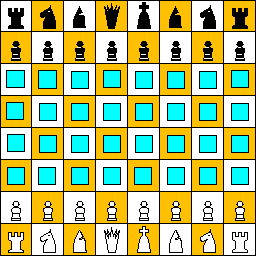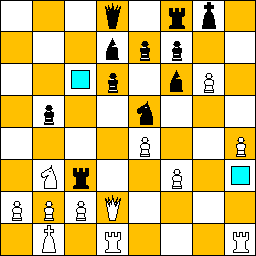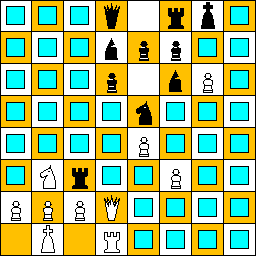Ice Age Chess
This is a fictituous variant in which air conditions are taken into consideration. If the board is filled with ice cubes, you can only move by capturing them. You can even open up some lines into the enemy territory.
If you want to play this variant with me, you can mail me at (email removed contact us for address) mail.com
Board and Setup

The game is played on a 8x8 board, with the usual setup plus the ice cubes, which are non-moving and neutral pieces. The empty squares that exist in orthodox chess setup are filled with ice cubes at the beginning in this variant.
White: King e1; Queen d1; Bishops c1,f1; Knights b1,g1; Rooks: a1,h1; Pawns a2, b2, c2, d2, e2, f2, g2, h2.
Black: King e8; Queen d8; Bishops c8,f8; Knights b8,g8; Rooks: a8,h8; Pawns a7, b7, c7, d7, e7, f7, g7, h7.
Ice cubes: a3, b3, c3, d3, e3, f3, g3, h3, a4, b4, c4, d4, e4, f4, g4, h4, a5, b5, c5, d5, e5, f5, g5, h5, a6, b6, c6, d6, e6, f6, g6, h6.
Moves and Rules
All pieces move just as in orthodox chess. When moving and capturing, the ice cubes should be considered as pieces. For example, white will start by capturing an ice cube with one of his pawns or knights.
At the beginning, it is the 1st Ice Age. After black makes his 20th move, the 2nd Ice Age comes; after black makes his 40th move, the 3rd Ice Age comes and so on.
In the beginning of an Ice Age (before 21st or 41st or 61st ... move of white), all of the squares , except those who have a black or white piece on all four orthogonally neighboring squares, are filled with ice cubes.
If a piece is isolated from all of the other (black or white) pieces at the beginning of an Ice Age, that piece is said to be frozen (because all 8 neighboring squares will be filled with ice cubes), and just taken off the board, and an ice cube is put also on the emptied square. (Note that a piece can only freeze when the Ice Age begins, if the piece, a knight for example enters just between 8 ice cubes, it does not freeze.)
If one of the kings is frozen, the side whose king survives wins the game. If two kings freeze at the same time the game is drawn.

As an example see the position at the left (actually this position is taken from Sicillian Dragon of Modern Opening Theory, two ice cubes added).
Let this position be the one that is after black's 20th move. Now the 2nd Ice Age comes, and the white rook at h1, the white pawn at h4 and the black pawn at b5 will be frozen, because they are isolated. See the next diagram.

Yes, the 2nd Ice Age has come, frozen pieces are taken away, and the remaining position is this.
Note that no ice cubes come to squares a1, c1, e8 and e6 because that squares are covered with pieces orthogonally.
Then white makes his 21th move and the game goes on.
Other Rules
Castling and en passant rules are OK with the same considerations as in orthodox chess.
The aim is to checkmate the opponent's king or to make it freeze at the beginning of an ice age. Note that a bishop and a king (or a knight and a king) can win against a bare king, using the freezing theme (isolating the opponent king and staying in touch).
3 move repetition move can be omitted if repeating the move (and keeping the position as it is), is an advantage for you, that at the beginning of the next Ice Age, some of the opponent pieces can be frozen.
For example white has his king at h5 and a pawn h4, he can win against a black king at h8, just keeping the position, or not letting the black king to touch the pawn. So the black king will freeze at the beginning of the next Ice Age and white will win.
(c) Köksal Karakus - 2000
Written by Köksal Karakus.
WWW page created: February 10, 2000.